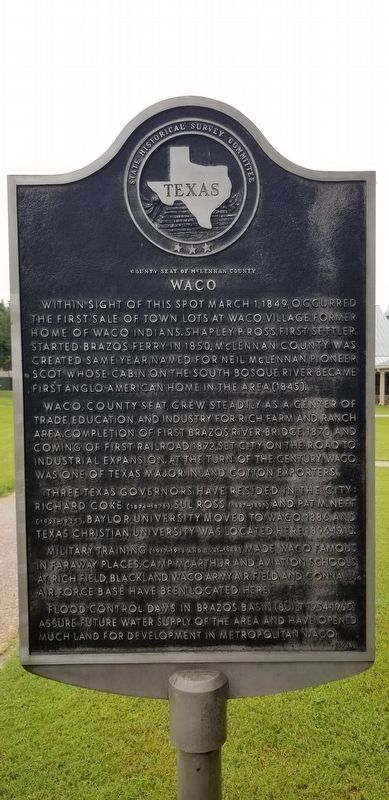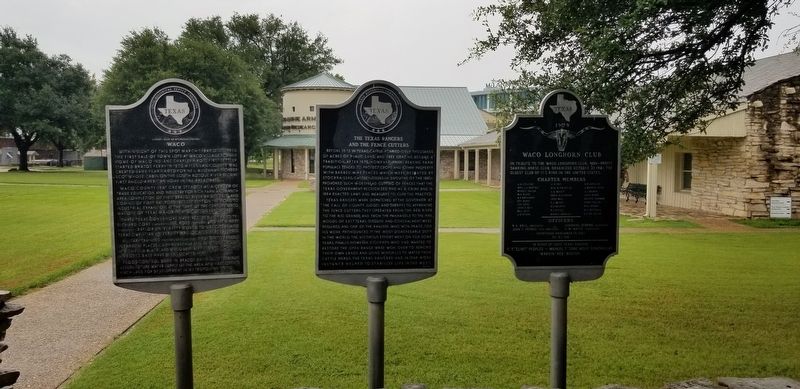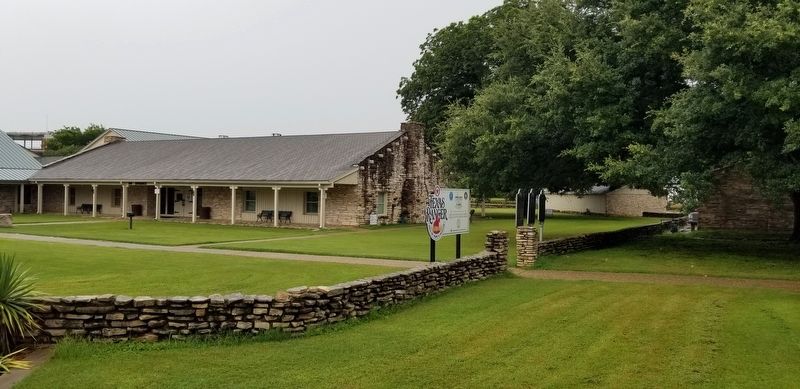Waco in McLennan County, Texas — The American South (West South Central)
Waco
County Seat of McLennan County
Within sight of this spot March 1, 1849, occurred the first sale of town lots at Waco Village, former home of Waco Indians. Shapley P. Ross, first settler started Brazos Ferry in 1850. McLennan County was created same year, named for Neil McLennan, pioneer Scot whose cabin on the South Bosque River became first Anglo-American home in the area (1845).
Waco, county seat, grew steadily as a center of trade, education, and industry for rich farm and ranch area. Completion of first Brazos River bridge, 1870, and coming of first railroad, 1872, set city on the road to industrial expansion. At the turn of the century, Waco was one of Texas major inland cotton exporters.
Three Texas Governors have resided in the city: Richard Coke (1874-1876), Sul Ross (1887-1891), and Pat M. Neff (1921-1925). Baylor University moved to Waco, 1886, and Texas Christian University was located here 1896-1910.
Military training (1917-1918 and 1941-1966) made Waco famous in faraway places. Camp McArthur and aviation schools at Rich Field, Blackland, Waco Army Air Field, and Connally Air Force Base have been located here.
Flood control Dams in Brazos Basin (built 1954-1965) assure future water supply of the area and have opened much land for development in metropolitan Waco.
Erected 1968 by State Historical Survey Committee. (Marker Number 5696.)
Topics. This historical marker is listed in these topic lists: Bridges & Viaducts • Industry & Commerce • Native Americans • Railroads & Streetcars. A significant historical date for this entry is March 1, 1849.
Location. 31° 33.321′ N, 97° 7.138′ W. Marker is in Waco, Texas, in McLennan County. Marker is at the intersection of Texas Ranger Trail and North Interstate 35 Frontage Road, on the right when traveling north on Texas Ranger Trail. The marker is located on the Texas Ranger Trail by the parking lot and next to the Texas Ranger Hall of Fame and Museum. Touch for map. Marker is at or near this postal address: 100 Texas Ranger Trail, Waco TX 76706, United States of America. Touch for directions.
Other nearby markers. At least 8 other markers are within walking distance of this marker. The Texas Rangers and the Fence Cutters (here, next to this marker); The Original Fort Fisher (within shouting distance of this marker); First Street Cemetery (about 300 feet away, measured in a direct line); Confederate Veterans Memorial (about 300 feet away); Thomas Hudson Barron (about 300 feet away); General Richard Harrison (about 300 feet away); 143rd Infantry 36th Division Memorial (about 300 feet away); Samuel Johan Forsgard (about 400 feet away). Touch for a list and map of all markers in Waco.
Also see . . . Waco, TX
.
Waco is in central McLennan County about seventy miles south of Dallas near the confluence of the Brazos and Bosque rivers. The city's transportation links include Interstate Highway 35, U.S. highways 84 and 77, State Highway 6, the Missouri Pacific Railroad, and the St. Louis Southwestern Railway. The city is built on the site of an ancient agricultural village of Waco Indians. About 1830 a group of Cherokee Indians moved into the area and drove the Wacos from the village. Fort Fisher, a Texas Rangers outpost and the first White settlement in the area, was established in 1837, but was abandoned after only a few months. In 1844 George Barnard began operating Torrey's Trading Post No. 2 on a small tributary of Tehuacana Creek, eight miles south of the old Waco village. A year later Neil McLennan moved onto land nearby on the South Bosque River. A log smithy was erected at the present site of East Waco in 1846 by Jesse Sutton, a blacksmith. In 1848 Gen. Thomas J. Chambers sold a two-league grant of land, including the old Waco village site, to John S. Sydnor of Galveston. Sydnor struck a deal with land agent Jacob De Cordova to divide the property and dispose of it at a dollar an acre. George B. Erath, who had first visited the area as one of the rangers stationed at the old 1837 outpost, was one of De Cordova's surveyors, and he urged that the new townsite be placed at the former Indian village. In 1848 the tract was sold to Nathaniel A. Ware and Jonas Butler of Galveston; they became De Cordova's partners in the venture. Source: The Handbook of Texas(Submitted on July 25, 2021, by James Hulse of Medina, Texas.)
Credits. This page was last revised on July 25, 2021. It was originally submitted on July 25, 2021, by James Hulse of Medina, Texas. This page has been viewed 529 times since then and 94 times this year. Photos: 1, 2, 3. submitted on July 25, 2021, by James Hulse of Medina, Texas.


